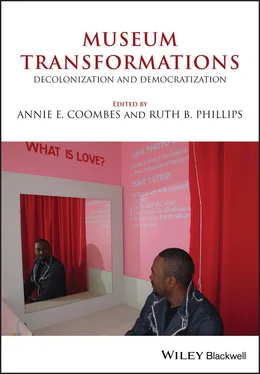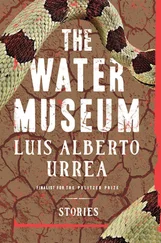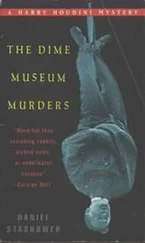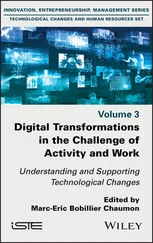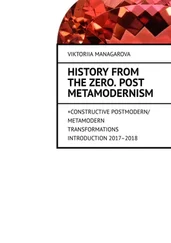1 Cover
2 Title page
3 Copyright
4 LIST OF ILLUSTRATIONS
5 EDITORS
6 GENERAL EDITORS
7 CONTRIBUTORS
8 EDITORS’ PREFACE TO MUSEUM TRANSFORMATIONS AND THE INTERNATIONAL HANDBOOKS OF MUSEUM STUDIES
9 INTRODUCTION: MUSEUMS IN TRANSFORMATION: Dynamics of Democratization and Decolonization
10 PART I: Difficult Histories 1 THE HOLOCAUST MEMORIAL IN BERLIN AND ITS INFORMATION CENTER: Concepts, Controversies, Reactions After the Holocaust Becoming aware of the fate of individuals Dealing with the past in the former GDR Memory discourse after unification A decision of the German Bundestag The Degussa debate Politics behind Memory: Underlying tensions An underground location Historians at work The basic concept Designing the information center: Continuity or counterpoint? Contemplation versus information Religious reading or historical remembrance? The Room of Names The outcome Reactions A moving experience References Further Reading 2 GHOSTS OF FUTURE NATIONS, OR THE USES OF THE HOLOCAUST MUSEUM PARADIGM IN INDIA Punjab Exile Tibet Conclusion: Ghosts of future nations Acknowledgments Notes References 3 THE INTERNATIONAL DIFFICULT HISTORIES BOOM, THE DEMOCRATIZATION OF HISTORY, AND THE NATIONAL MUSEUM OF AUSTRALIA Refounding settler nations A national museum for Australia History wars The democratization of history Bells Falls Gorge and the Wiradjuri War exhibit Review and renewal Conclusion Acknowledgments References Further Reading 4 WHERE ARE THE CHILDREN? AND “WE WERE SO FAR AWAY …”: Exhibiting the Legacies of Residential Schools, Healing, and Reconciliation The truth, healing, and legacy landscape “We Were So Far Away …”: The Inuit experience of residential schools Conclusion Notes References 5 RECIRCULATING IMAGES OF THE “TERRORIST” IN POSTCOLONIAL MUSEUMS: The Case of the National Museum of Struggle in Nicosia, Cyprus Historical context Terrorists Torture and heroism Bringing pain into vision Death by hanging Notes References 6 REACTIVATING THE COLONIAL COLLECTION: Exhibition-Making as Creative Process at the Tropenmuseum, Amsterdam A history of transformation The creative process Communicating colonialism The Colonial Theater visited and revisited Conclusion Notes References Further Reading 7 “CONGO AS IT IS?”: Curatorial Reflections on Using Spatial Urban History in the Memory of Congo: The Colonial Era Exhibition “Belgium exhumes its colonial demons”? (Re)presenting Congo’s colonial past Visualizing the “color bar” Living apart together Blurring the image of the dual city Spatializing cosmopolitanism Visualizing violence Whose Congo? Acknowledgments Notes References 8 BETWEEN THE ARCHIVE AND THE MONUMENT: Memory Museums in Postdictatorship Argentina and Chile Reasserting truth: Santiago de Chile’s Museum of Memory and Human Rights Arts of memory: Rosario’s Museum of Memory Conclusion Notes References 9 THE GENDER OF MEMORY IN POSTAPARTHEID SOUTH AFRICA: The Women’s Jail as Heritage Site Cinema and the media Monuments The Women’s Jail Conclusion Acknowledgments Notes References
11 PART II: Social Agency and the Museum 10 AN ETHNOGRAPHY OF REPATRIATION: Engagements with Erromango, Vanuatu Repatriation The Vanuatu Kaljoral Senta Erromango Barkcloth Knowledge Forms of repatriation Repatriation and return Notes References 11 OF HERITAGE AND HESITATION: Reflections on the Melanesian Art Project at the British Museum References 12 THE BLACKFOOT SHIRTS PROJECT: “Our Ancestors Have Come to Visit” Planning the Blackfoot Shirts Project The Blackfoot shirts in Canada The responses of high school and college students Knowledge repatriation: Museum and community expectations Concluding thoughts Notes References 13 “GET TO KNOW YOUR WORLD”: An Interview with Jim Enote, Director of the A:shiwi A:wan Museum and Heritage Center in Zuni, New Mexico The origins of a museum for the Zuni people Thinking about collective knowledge: An interview with Jim Enote Conclusions and future conversations Notes References 14 THE PARO MANENE PROJECT: Exhibiting and Researching Photographic Histories in Western Kenya Luo photographs “Looking past”: Interpretive frameworks and local expectations The exhibitions Photographic homecomings Conclusion Notes References 15 REANIMATING CULTURAL HERITAGE: Digital Curatorship, Knowledge Networks, and Social Transformation in Sierra Leone The Sierra Leonean object diaspora and its remittances Reanimating museum objects in digital space From source communities to knowledge networks Working across the digital divide Strengthening relationships, building capacity Reanimating cultural heritage, reanimating civil society? Notes References 16 ON NOT LOOKING: Economies of Visuality in Digital Museums To look or not to look? Not looking Access and authority: Visuality and textuality “It’s time to repaint that picture” Acknowledgments Notes References 17 PRESERVING THE PHYSICAL OBJECT IN CHANGING CULTURAL CONTEXTS The physical use of objects from museum collections More challenges to core conservation values The authority for conservation decisions Challenges to conservation from within Western values Conclusion Acknowledgments Notes References Further Reading
12 PART III: Museum Experiments 18 THE LAST FRONTIER: Migratory Culture, Video, and Exhibiting without Voyeurism Landscapes of Madness Towards the Other Parties and encounters Migratory aesthetics Reunion, resilience, resistance Failed encounters: The problems of identification At home? Metaphors museums live by Notes References 19 PUBLIC ART/PRIVATE LIVES: The Making of Hotel Yeoville Tegan Bristow, Terry Kurgan and Alexander OpperIntroduction On Rockey Street Exploring the ground Culture as infrastructure Going live Who wants what Photography, Facebook, and human rights Tegan Bristow Research and insights Nets are for catching Interactive encounters in flow Anonymity Alexander Opper New exhibition models Conclusion Acknowledgments Notes References 20 MUSEUMS, WOMEN, AND THE WEB The web advantage A brief history of feminist exhibitions on the web WACK! Global Feminisms elles@centrepompidou Shifting the Gaze References Websites Further Reading 21 MÖBIUS MUSEOLOGY: Curating and Critiquing the Multiversity Galleries at the Museum of Anthropology at the University of British Columbia Transforming aboriginal–museum relationships in the multiversity galleries Working with Dzawada’enuxw community members in the Multiversity Galleries Working with Nuxalk community members in the Multiversity Galleries Conclusions Postscript Notes References Further Reading 22 WHEN YOU WERE MINE: (Re)Telling History at the National Museum of the American Indian References 23 AGAINST THE EDIFICE COMPLEX: Vivan Sundaram’s History Project and the Colonial Museum in India Notes References 24 CAN NATIONAL MUSEUMS BE POSTCOLONIAL?: The Canadian Museum for Human Rights and the Obligation of Redress to First Nations Initiating redress, countering the vanishing Indian, 1967–2011 Minding the gaps: The CMHR and the problem of redress Acknowledgments Notes References
13 INDEX
14 End User License Agreement
1 INTRODUCTIONFIGURE 0.1 (a) Display of masks made by the Kalabari peoples from the Niger Delt...FIGURE 0.2 The Sainsbury Africa Gallery at the British Museum, showing the Tree ...FIGURE 0.3 Recreated Mohawk Family diorama, 2012, The Daphne Cockwell Gallery of...FIGURE 0.4 Visual Sovereignty Dance performed by Git Hayetsk at Masq’alors! Inte...
2 Chapter 1FIGURE 1.1 The Memorial to the Murdered Jews of Europe in Berlin, facing the Tie...FIGURE 1.2 Room of Dimensions, Memorial to the Murdered Jews of Europe. Eyewitne...FIGURE 1.3 Room of Names, Memorial to the Murdered Jews of Europe. The room is e...FIGURE 1.4 Room of Families, Memorial to the Murdered Jews of Europe. Different ...
Читать дальше
